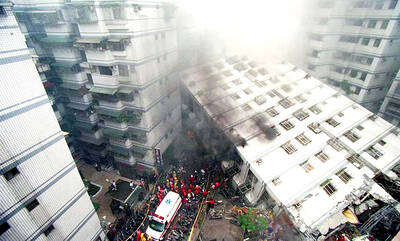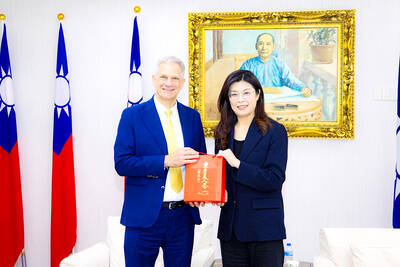Persian Heaven, which opened five years ago, stands out on Taipei’s dining scene as one of the few places to sample Persian cuisine. Founded by an Iranian businessman, the dining lounge on Nanjing East Road (南京東路) features regular belly dance performances. Subdued lighting, loud music and cabinets filled with knick-knacks like busts of ancient Persian kings add to the fun and slightly kitschy atmosphere.
For an extra NT$150, most entrees are available as set meals, which are a bargain if you want to get a sampling of Persian Heaven’s expansive menu. Each set comes with a full-sized salad, soup, appetizer, side dish, dessert and drink, in addition to the main course.
We paired ghorme sabzi, or stewed beef cooked with split peas and vegetables (NT$370), with an order of Iranian bread (NT$60). Made from white flour, the bread was thin and chewy, like a tortilla, and not particularly memorable. The beef in the ghorme sabzi was juicy and the dish would have gone better with Persian Heaven’s saffron polo (NT$80), or white rice flavored with fragrant saffron.
The upbeat-sounding triple happy kebab king (NT$530) features a skewer each of beef, lamb and chicken and is probably the most attractive dish on the menu, with the gleaming chunks of meat set off by a colorful assortment of vegetables. The meat was succulent but had little seasoning, so we made sure to douse each skewer in limejuice to set off the flavor. On a separate visit, I ordered the meat and seafood combo kebab (NT$550), which came with two meaty, perfectly grilled tiger prawns, along with lamb (beef is another option).
Most of Persian Heaven’s salads use potato as the main ingredient, including the delicious chilled salad Olivier (NT$100), in which the tuber is diced and mixed with celery and chicken. There are only two appetizers. The seafood plate (NT$100) is a patty of chilled mashed potatoes served with a steamed prawn and garnished with relish and dill. It was OK, but the heaven chicken roll (NT$100), a light crepe stuffed with chicken and garnished
with a savory cream sauce, is much better.
Persian Heaven’s soups are passable, but if you aren’t ordering a set meal, I suggest skipping them to save room for dessert. Made from semolina and butter and flavored with honey and saffron, the hal wa (NT$80) was surprisingly delicate instead of overpoweringly sweet. The texture was like a thick pudding, making the treat a great comfort food. It tasted especially good with a glass of tart lemonade, which came with the set meal. Another good bet is the thick, creamy rice pudding (NT$80). It was complemented by a glass of cinnamon-y iced Iranian tea (NT$120, also available hot).
Our servers were uniformly polite and helpful on both visits, but we waited half an hour for our main entree (the triple happy kebab king) on a busy Sunday night — enough time, in fact, to watch the cheerful belly dancer teach two diners how to roll their hips. Dinner on a weekday moved at a quicker pace — each course was served as soon as I had finished the previous one.

Seven hundred job applications. One interview. Marco Mascaro arrived in Taiwan last year with a PhD in engineering physics and years of experience at a European research center. He thought his Gold Card would guarantee him a foothold in Taiwan’s job market. “It’s marketed as if Taiwan really needs you,” the 33-year-old Italian says. “The reality is that companies here don’t really need us.” The Employment Gold Card was designed to fix Taiwan’s labor shortage by offering foreign professionals a combined resident visa and open work permit valid for three years. But for many, like Mascaro, the welcome mat ends at the door. A

Last week gave us the droll little comedy of People’s Republic of China’s (PRC) consul general in Osaka posting a threat on X in response to Japanese Prime Minister Sanae Takaichi saying to the Diet that a Chinese attack on Taiwan may be an “existential threat” to Japan. That would allow Japanese Self Defence Forces to respond militarily. The PRC representative then said that if a “filthy neck sticks itself in uninvited, we will cut it off without a moment’s hesitation. Are you prepared for that?” This was widely, and probably deliberately, construed as a threat to behead Takaichi, though it

If China attacks, will Taiwanese be willing to fight? Analysts of certain types obsess over questions like this, especially military analysts and those with an ax to grind as to whether Taiwan is worth defending, or should be cut loose to appease Beijing. Fellow columnist Michael Turton in “Notes from Central Taiwan: Willing to fight for the homeland” (Nov. 6, page 12) provides a superb analysis of this topic, how it is used and manipulated to political ends and what the underlying data shows. The problem is that most analysis is centered around polling data, which as Turton observes, “many of these

Since Cheng Li-wun (鄭麗文) was elected Chinese Nationalist Party (KMT) chair on Oct. 18, she has become a polarizing figure. Her supporters see her as a firebrand critic of the ruling Democratic Progressive Party (DPP), while others, including some in her own party, have charged that she is Chinese President Xi Jinping’s (習近平) preferred candidate and that her election was possibly supported by the Chinese Communist Party’s (CPP) unit for political warfare and international influence, the “united front.” Indeed, Xi quickly congratulated Cheng upon her election. The 55-year-old former lawmaker and ex-talk show host, who was sworn in on Nov.